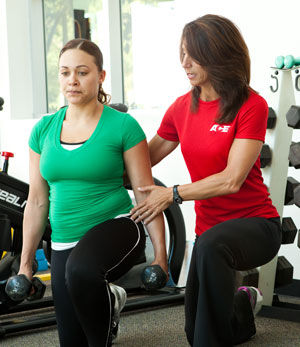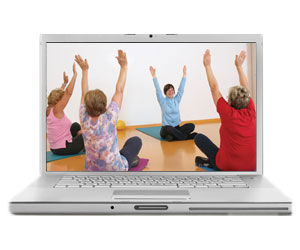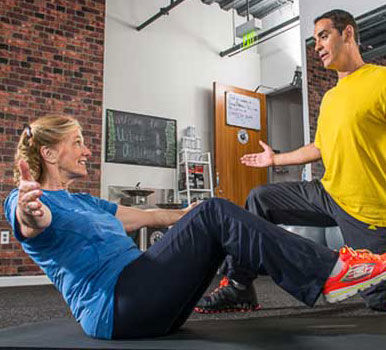
There are some clients who stride into the gym ready to work and with a smile on their faces. Others drag themselves in, griping about waking up early and the horrors of the drop-off line at their kids’ schools that morning. Some group fitness participants seem to love the experience and relish the social support that the group provides, while others go through the motions and hurry out as soon as the minute hand hits 12. There are countless reasons why someone may be dragging on a particular day—illness, stress, fatigue or simply a rough morning—but if you see this on a consistent basis from a client or participant, the source of his or her motivation may be worth exploring.
Most fitness-related textbooks highlight the need to help clients or participants transition from being extrinsically motivated to being intrinsically motivated. According to the ACE Personal Trainer Manual (5th ed.), “To be intrinsically motivated, in the exercise context, means that a person is engaged in exercise activity for the inherent pleasure and experience that comes from the engagement itself” (ACE, 2014). People who are extrinsically motivated, on the other hand, report being physically active because of some external factor (e.g., to lose weight, to be healthy, to make their spouse happy or to look good).
The problem with most forms of extrinsic motivation is that, if that external goal is not being met, the motivation to continue evaporates. For example, if a client is exercising purely to lose weight, what happens when he hits a plateau and the scale refuses to budge? Tying exercise participation exclusively to an objective, whether that is weight loss, a decrease in blood pressure or keeping a doctor or loved one off your back, leaves the client or participant struggling when that objective is not being met, or is not being met quickly enough.

Is There Any Place for External Rewards?
Let’s assume for a minute that your fitness facility is not full of people exercising for the pure joy of movement. Most gyms organize group challenges to get people moving together and offer rewards for participation—maybe a T-shirt, a free month of membership or a 30-minute massage. But isn’t that undermining the quest for intrinsic motivation?
Pete McCall points out that goal setting is a huge part of the client–trainer or client–coach relationship. He says that initial goals should focus on frequency, not intensity or weight loss, as the objective should be to make exercise a regular habit. Offering small rewards as extrinsic motivators may help otherwise reluctant newcomers through the door and focused on a short-term goal, but they should be used sparingly, if at all. Consider a new client who comes to the gym three times a week during her first month of membership and wins a T-shirt for her efforts. What happens during the second month if you no longer offer a reward?
Most of the pros we spoke to advised against the use of this type of reward, as your focus as a trainer or coach should be exclusively on the development of permanent lifestyle change.
Barbara Brehm, a professor of exercise and sport studies at Smith College in Northampton, Mass., and author of Psychology of Health and Fitness, points out that thinking about motivation as either “intrinsic” or “extrinsic” is an oversimplification. “These are really two ends of a spectrum or continuum, and intrinsic and extrinsic are broad categories that include multiple subtypes of motivation.” Therefore, labeling intrinsic motivation as “good” and extrinsic motivation as “bad” is an invalid construct. For example, Brehm explains that autonomous extrinsic motivation, where an individual has made his or her own decision to exercise in order to achieve a goal, is far more positive than controlled extrinsic motivation, where a client feels forced to exercise because of doctor’s recommendations or a nagging spouse. Very few of us ever achieve purely intrinsic motivation, where we are exercising solely for the pleasure of the experience, explains Brehm, so understanding and getting to the source of a person’s motivation is essential for long-term success.
Consider a new client who comes to you for help with a weight-loss program after being told by his doctor that shedding some pounds would go a long way toward alleviating his chronic back pain. He can respond in one of two ways: (1) He may perform the exercises with resentment and resistance in response to being told what to do, or (2) he can act with an attitude of willingness that reflects an inner acceptance of the value of the program (Ryan and Deci, 2000). This marks the difference between controlled and autonomous motivation.
Facilitating the Development of Motivation
According to Ryan and Ryan (2000), health and fitness professionals can facilitate intrinsic motivation in their clients by supporting the need for autonomy and competence. Challenging clients to learn new skills and then creating an atmosphere that allows time and provides instruction to achieve mastery is an excellent example of this. It is important to note that, no matter what the trainer, instructor or coach does, intrinsic motivation will occur only when the individual has an intrinsic interest in the activity at hand (Ryan and Deci, 2000). According to Ryan and Deci (2000), “intrinsic motivation exists in the nexus between a person and a task.” Stated more simply, every person has varying levels of intrinsic motivation for different tasks and behaviors in his or her life.
For example, a group fitness participant may love going to class and seeing her friends, but struggle to find the motivation to prepare a healthy lunch during the workday. Her best friend, meanwhile, may feel the exact opposite. This is why it is so important to individualize your approach to each participant and each activity, explains Brehm. Your goal should be to find that intersection between the client and physical activity where intrinsic motivation can be maximized.
Tips From the Pros
Speaking with a half-dozen health and fitness professionals revealed that the number one question you should be asking your clients is “Why?” Why do you want to lose weight? Why is lowering your blood pressure important to you? Why do think improving your balance will improve your lifestyle? Why do you think you need help managing your stress? Why do you need more energy?
It’s all about uncovering what’s important to the individual and then exploring why it is so important. Jacque Crockford is an exercise physiologist and Education Specialist at ACE and an ACE Certified Personal Trainer and Health Coach. She says that, while many clients and participants may offer superficial explanations for why they need your help, “if they didn’t actually believe something about themselves that indicates a health change is needed, they wouldn’t even be talking to a health and fitness professional in the first place.” It may take some time to uncover the true “why” behind a behavior change, but asking probing questions along the way will help.
According to Justin Price, creator of The BioMechanics Method, people who take the step of seeking out a health and fitness professional have already found the initial motivation they need to get started, but he agrees that asking intelligent questions and giving people the confidence they need to trust in their skills and abilities to succeed is essential. Price says that health and fitness professionals should focus on intrinsic motivation beginning at the initial consultation. “It leads to better relationships and better long-term adherence,” he says. “The more you feed into someone’s extrinsic motivation, the harder it is to convert to intrinsic.”
Pete McCall, faculty in the Exercise Science Department at Mesa College in San Diego, Calif., and an ACE Certified Personal Trainer, raises yet another important consideration. “We are dealing with an emotional and sensitive issue: an individual's self-image. It can take some work to develop a relationship with a client to identify the real reason why he or she started an exercise program.”
Kelley Vargo, part-time faculty in exercise and nutrition science at the Milken Institute School of Public Health at The George Washington University in Washington, D.C., and an ACE Certified Health Coach and Behavior Change Specialist, agrees that health and fitness professionals should make very limited use of extrinsic motivation. “There is always something intrinsic behind the extrinsic motivator,” she says, “and it is our job to draw that out of the individual.”
It is also important to explore habits and strategies that have worked for an individual in the past. Price suggests that you ask each client about the skills he or she already possesses and then fuel that fire. If a client mentions that she used to work out consistently, but that it’s been many years since she did so, ask about what was different in her life that allowed the success, what she did then to stay motivated and what strategies she used to stay on track. By having the client search for answers, rather than providing your own ideas on how to stay motivated, you empower the client to be the driver of her own success.
Dr. Brehm echoes this idea: “By asking, ‘When have you been successful in the past?’ you allow the individual to explore his or her goals and preferences.” Perhaps that past success can be duplicated, but with your support making the difference in terms of long-term adherence.
Sometimes, finding a client’s intrinsic motivators is about raising the stakes beyond the surface reasons for behavior change. According to Allison Hagendorf, television personality and an ACE Certified Health Coach, “a desire for aesthetic-based results doesn’t raise the stakes high enough for most people. The pain of staying the same has to be greater than the pain of change.”
And this brings us back to the question of “why?” For some clients, the goal to “lose weight” or “get in better shape” may be rooted in a desire to ward off disease or lessen the impact of a chronic injury.
“Wellness is a spectrum,” says Hagendorf, “and we all deserve to be at the positive end of that spectrum. I encourage my clients to embrace that ideology as the foundation of their intrinsic motivation.”
Conclusion
The concept of a spectrum or continuum has been raised twice in this article, once in terms of nudging clients or participants along the continuum from extrinsic to intrinsic motivation and again when Allison Hagendorf discussed the wellness spectrum. Similarly, the ACE manuals all discuss the function–health–fitness–performance continuum, again coupled with the idea of helping people move slowly but steadily in a positive direction.
What continuums tell us is that the idea of all-or-nothing thinking is almost always misguided. Instead, people should be encouraged and taught how to take small steps in the right direction in order to achieve lifelong behavior change.
According to McCall, the challenge for a health and fitness professional is how to guide clients from extrinsic to intrinsic motivation so that they learn how to stay motivated to suit their own interests and not for the approval of others.
Price also points out that, throughout daily life, people are bombarded with extrinsic motivators. Every advertisement, magazine cover and piece of unsolicited advice offers extrinsic motivators, and they are always short-term and always changing. It is your job as a health and fitness professional to help clients find the source of their own intrinsic motivation. From there, you can help them explore what they have done in the past that has worked for them, what they are currently doing to drive their own success and what they can do in the future to stay on track.
References
American Council on Exercise (2014). ACE Personal Trainer Manual (5th ed.). San Diego, Calif.: American Council on Exercise.
Ryan, R.M. & Deci, E.L. (2000). Intrinsic and extrinsic motivations: Classic definitions and new directions. Contemporary Educational Psychology, 25, 54–67.





 by
by 







